One week into his term, President Donald Trump devastated tens of thousands of people with the stroke of a pen.
Throughout the campaign, Trump had vowed to enact a Muslim ban. His fifth executive order effectively made good on that promise, banning people from seven countries — all majority-Muslim — from entering the United States.
Immediate chaos followed. People were stranded at airports. Families were kept apart. Refugees set to finally find safety in the US after years of navigating international bureaucracies were abruptly abandoned.
That day proved to be a harbinger of what was to come. For the next four years, Trump followed up with policies, actions and comments that were tremendously painful for hundreds of thousands of people. That suffering was borne primarily by minorities and people of colour: Latinos he demonised, Black people he denigrated for protesting against racism and brutality, Muslims he continually attacked, transgender people he licensed discrimination against, Asian Americans he insulted.
Trump separated thousands of immigrant children from their parents in a policy that will go down in history as among the cruelest actions of his administration. He downplayed the coronavirus pandemic, which has thus far killed at least 375,000 Americans.
Trump riled up supporters in opposition to his perceived foes: Democrats, particularly women of colour such as Rep. Ilhan Omar; whistleblowers such as Lt. Col. Alexander Vindman; election workers who he suggested were part of a massive fraud campaign; public health workers who pushed for more safety precautions to stop the spread of COVID-19.
He defended white nationalist protesters as “very fine people” after they descended on Charlottesville, Virginia. He called Haiti and African nations “shithole countries,” a view he would have followed up with action to decrease immigration had he won support from Congress. He insulted the women who accused him of sexual assault. He encouraged supporters to overturn the election in statements that led to an insurrection at the Capitol last week, a move that led to him being impeached for a second time on Wednesday.
The Trump era will be remembered for many things, including corruption and extremism. For many people, it will also be remembered as a time of immense pain — a time when the nation’s highest power, a man purportedly the president to all Americans, turned his aim on them.
We asked 14 people to share with us, in their own words, what it was like to live through it.

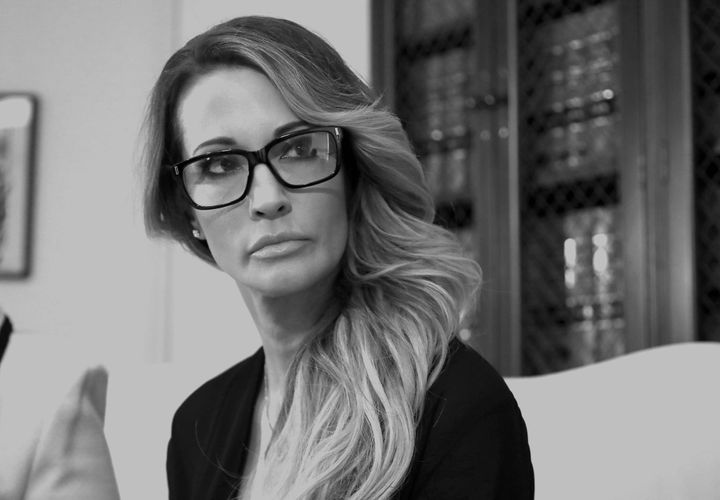
October 22, 2016
Jessica Drake, an adult film actor, director and sex educator, accused Trump of grabbing and kissing her without her consent in 2006. She also said Trump offered her $10,000 to have sex with him at a Lake Tahoe golf tournament.
Trump called her allegations “total fiction,” and his campaign continually smeared her character to undermine her claim. He later insinuated that Drake’s accusation didn’t matter because she was an adult film actor.
It was terrifying [coming forward with my story], and it wasn’t a decision I made overnight. I understood that it would alter the course of my life significantly. However, it was extremely important to me that I speak out and share my personal experience prior to the election.
When his campaign denied my claims, it was frustrating yet expected ― I knew that was their method. When he was doing a New Hampshire radio interview and said: “One [woman] said, ‘He grabbed me on the arm.’ And she’s a porn star… Oh, I’m sure she’s never been grabbed before.” That infuriated me. His dismissal of my claims being based on my occupation was unfair.
At first, when he won the election, I felt like nothing I had said or did mattered. I was devastated. Today, his fan base continues to hate me. I get hateful messages on social media. Some folks have thanked me. Some of the other women who came out against him have reached out to me in support. For me, the decision to speak out was a fork in the road of my life. I had always been somewhat of an activist, but coming forward set me on a path I won’t turn back from.
― As told to Alanna Vagianos

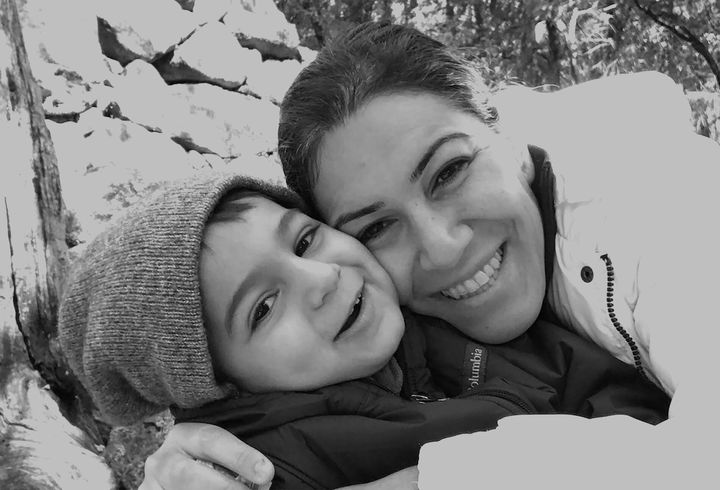
January 27, 2017
Trump made good on his promise for “a total and complete shutdown” of Muslims entering the United States when he signed an executive order banning foreign nationals from several predominately Muslim countries. Since then, the ban has been challenged in courts, upheld by the Supreme Court, revised, and expanded. Thousands of people were separated from their families, missing weddings and funerals, education and work opportunities, and denied seeing their loved ones for years.
Among them was Mina Mahdavi, a 39-year-old solutions and cybersecurity engineer in California who has not been able to bring her mother from Iran to the U.S. because of the Muslim ban.
My mom is an avid traveler. I used to live in Canada and she visited me in Canada. She traveled all over Europe. She visited me here in the U.S. twice. And then, in 2016, I decided to have a kid, and I was planning to have my mom with me.
My son was born in May 2017, and I was still in denial. I thought, there’s a waiver process, we can ask for a waiver. She’s gonna make it. Maybe not the first couple of months, but she’s gonna make it. And then, after it got rejected like 15, 16 months later, it sort of settled in — I can’t have my mom here. Period.
I went through depression. It’s hard. I don’t know how to describe it. It’s hard.
At first, I was still hopeful. I was thinking, maybe not now, but she’s going to come. Not today, but she was going to come like next week. She even packed her stuff. She was ready. The moment that she would get the visa, she would just fly. And then she sort of started unpacking, I guess, after a while.
I still see people in the park with their grandkids ― a grandma or grandpa — and I don’t know why I don’t have it. Why my kid doesn’t have that? I’m still crying. It’s been four years.
― As told to Rowaida Abdelaziz

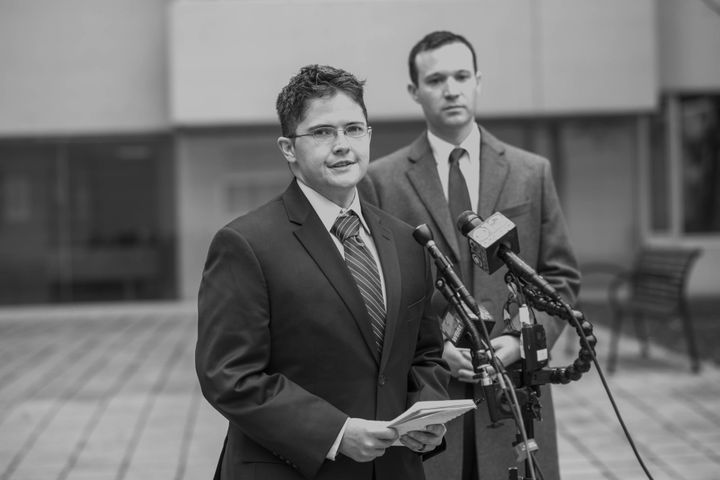
July 26, 2017
Trump announced in a series of tweets that he planned to ban transgender people from serving in the military in “any capacity.” The controversial policy, implemented on April 12, 2019, stated that trans people are only allowed to enlist in the military under the sex they were assigned at birth. The policy effectively banned transgender people from enlisting in the military, while forcing current trans service members who had already transitioned back into the closet.
Brock Stone, an 11-year Navy veteran and transgender man, was one of those affected by Trump’s ban. The 37-year-old is one of several plaintiffs in an ongoing lawsuit against the Trump administration over its ban on transgender service members.
I remember being terrified. I didn’t know how quickly it would all happen. I didn’t know what the legal procedure would be. It was the commander in chief saying this. Does he give the order and then I fill out my paperwork and I’m out in 30 days and I hope I can find a job quickly? I had no idea.
Of all of my feelings, I never wished I hadn’t come out. It was more anger that I had gained that visibility and they were trying to erase me. They weren’t telling me to detransition, they were telling me: Go away.
This wasn’t just a job to me. At the time, I took quite a bit of pride in being part of the military. It felt like I was part of something bigger than myself. It wasn’t a religious experience for me, but it was kind of a crisis of faith. It was a big chunk of my reality turned on its head.
I remember when I was approached to join the lawsuit. I initially had said I needed to think about it. Ultimately, I thought, I can wait for somebody else to do this for me or I can do it myself. Now I know I did what I should’ve done.
― As told to Alanna Vagianos

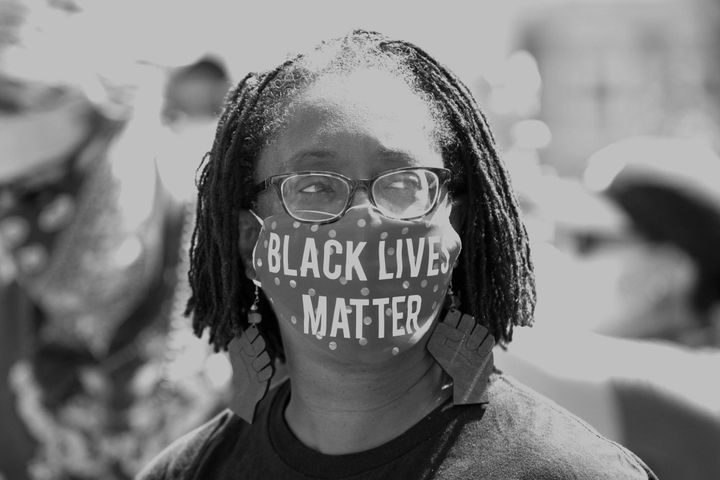
August 12, 2017, and August 15, 2017
During the weekend of Aug. 11, 2017, white nationalists descended on Charlottesville, Virginia, for the “Unite the Right” rally. The crowd, which chanted racist and anti-Semitic statements, included neo-Nazis and members of other extremist hate groups. A man drove a car into a crowd of counterprotesters demonstrating against hate in their city, and a woman named Heather Heyer was killed.
On Aug. 12, Trump addressed the violence by stating, “We condemn in the strongest possible terms this egregious display of hatred, bigotry and violence on many sides ― on many sides.” He defended the comments on Aug. 15, saying, “You have people who are very fine people on both sides” and claiming he was referring to people protesting against removing monuments to Confederates and racists.
Lisa Woolfork, an anti-racist organizer in Charlottesville, reflects on what those comments signified.
I was at the intersection when the white supremacist drove his car through the crowd. What I remember was hearing a loud bang. And then I saw a shoe in the air about 20 feet above me. It was chaos. Absolute chaos.
[Trump’s comments were] in the immediate aftermath. We hadn’t even fully parsed what had happened. I remember standing here at our house in the living room, and my husband had read his statement aloud, I heard it. And I felt chills. I felt like someone had thrown a bucket of ice cold water over my head, and it was dripping down my body. I felt such rage. This was adding insult to injury. We had already had an injury. And the president of the United States piled on the insults. And it was an announcement that reflected everything that we had long known about this administration: that they had chosen their side and they were speaking to their base, which is a racist, white supremacist, fascist spirit that has infected American democracy. This is also the outcome of when you don’t acknowledge that American democracy has always had at its core a form of racism and white supremacy.
This administration dispensed with the need for dog whistles, and then just shouts it from a bullhorn. You cannot unring a bell. You cannot.
― As told to Elise Foley

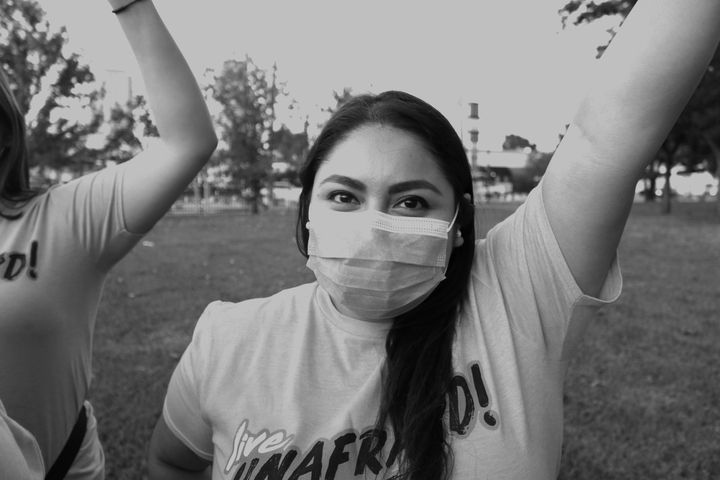
September 5, 2017
Trump announced he was ending the Deferred Action for Childhood Arrivals program, or DACA, an Obama-era policy that granted temporary work permits and deportation reprieve to about 800,000 undocumented young people who came to the U.S. as kids. He was later blocked in court.
One of these so-called Dreamers was Gabriela Cruz, a 31-year-old who lives in Santa Cruz, California, and now works for the advocacy group United We Dream and its political arm, United We Dream Action.
I was so numb that day. I couldn’t process what was happening. I immigrated to the country when I was only a year old, so I’ve been here for 30 years. I didn’t get DACA until I was 23 years old. And so for me, I’d built a whole career. I had finally found stability in my life where I wasn’t fearful anymore. At work I told myself, just keep it together to 5 p.m. and then afterward, you can cry, you can do whatever you feel like you need to do.
I had never really been to a protest. But I wanted to be around people. I made this huge sign that said “Santa Cruz Dreamer.” And that was the first time that I ever called myself that. It actually ended up being the first day I actually shared my story out loud in public.
The last four years have been just so horrible. It’s taken a toll on me mentally, physically. Now, I feel like I can finally take care of myself again. I couldn’t do that the last four years because I was fighting for my life.
― As told to Elise Foley

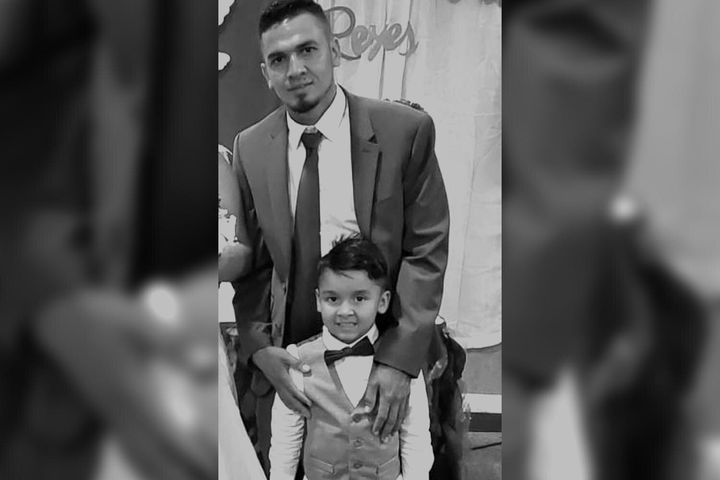
April 6, 2018
In 2018, then-Attorney General Jeff Sessions announced the implementation of Trump’s “zero-tolerance” immigration policy. The order separated migrant children from their parents who were detained when they entered the U.S., causing a national uproar after photos of traumatized young children screaming and crying went public. After mounting pressure from lawmakers and advocates, Trump signed an executive order ending the policy a year later.
Javier Garrido, 33, an immigrant from Honduras, crossed into the U.S. with his son. He was separated from his son, who was 4 at the time, for three months.
I left fleeing for my life. It was in 2018. I left my country in March. I turned myself in at the bridge to ask for help. They detained me for three days when they separated me from my son. They took him from me. They left me at the border, over in Texas, and they took my son to New York.
That was painful. I never thought they’d take him from me. If I’d have known, I would have stayed and faced the violence in my country, rather than have them take my son. When they took him, the first thing the officer told me was that they were going to put him up for adoption for a family here in the United States. That was painful. If I’d have known that they would take away my kid like that, I wouldn’t have come.
It went on for three months, me in one place and my son in another. They told me they would deport me along with my child, but I said, “I don’t care, as long as I get to see him. I’m going to Honduras. And later I’ll find some way to go to another country. But I want my son.”
The day [we reunited] was the happiest day of my life, as happy as the day my son was born. I was so happy when they gave him back to me because my head had been spinning, wondering whether they would give him back or not, or whether a family here would end up adopting him.
It’s the saddest thing they can do, to separate someone from their family. I don’t wish it on anyone. I don’t think they should do it. Better to send them back together if someone comes here with their family, but don’t split them up because that’s painful.
I spent about two months knowing nothing about my son, I didn’t know where he was, I didn’t know anything. I had to call family in Honduras, so they could try to figure out where my son was. I don’t wish this upon anyone.
― As told to Rowaida Abdelaziz

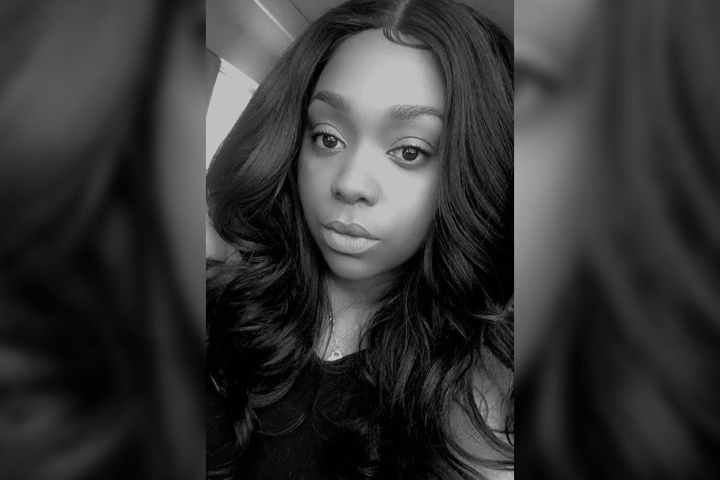
January 2019
The U.S. government came to a screeching halt in late December 2018. It remained remain shuttered for 35 days after Trump demanded Congress carve out in its appropriations bill nearly $6 billion to fund his wall along the U.S.-Mexico border.
About 380,000 federal employees were furloughed and another roughly 420,000 were expected to continue working with their pay delayed until the shutdown ended. An estimated 1.2 million federal contractors ― including 31-year-old Ashante Clay of Virginia ― were also impacted.
And while many of these workers received back pay once the government reopened, the stress of trying to make ends meet in the interim had lasting impacts for some.
It was pretty scary. It was like I was employed one week and then I just wasn’t employed the next. I’m a single mom, so I still had day care and all my bills to pay.
I was on unemployment for like three or four months. I was job searching outside of the government. After two government shutdowns with my company, it just didn’t seem like the field to be working in. It was just too volatile.
To say it was overwhelming would be an understatement. I didn’t expect to ever lose my job. I wasn’t prepared, and I was just barely making it with day care and bills and everything. Losing that income ― it was really stressful.
I did not want a border wall and I was very, very upset that something that’s so terribly discriminatory and racist, something I didn’t even want or support, cost me my job. And the people who were making these decisions did not care that their squabbling with each other was having real-life consequences to working people like myself.
I don’t really follow a lot of the political chatter ― it’s just kind of too much ― but I never heard any lawmakers or anybody who was in support of the wall talking about the people who were losing their jobs or not being able to pay their bills just because of this border wall.
― As told to Hayley Miller


April 13, 2019
On April 13, 2019, Trump tweeted out a video falsely suggesting that Rep. Ilhan Omar (D-Minn.), who just five months earlier had become the first Somali American and one of the first two Muslim women ever elected to Congress, had tried to justify the Sept. 11, 2001, terror attacks. Trump has since made Omar one of the most consistent targets of his racist and Islamophobic rhetoric, repeatedly saying she should “go back” to Somalia, where a civil war made her a refugee as a child. At his rallies, crowds of his fans have chanted “Send her back” about Omar.
In November 2019, a Trump supporter pleaded guilty to making death threats against the congresswoman; Omar wrote to the sentencing judge asking him to be compassionate in his decision. Despite proof of the impact of his own vitriol ― which prompted investigations by both the FBI and the U.S. Capitol Police ― Trump has continued smearing Omar, apparently seeing it as politically useful to elevate his feud with the first member of Congress to wear a Muslim headscarf.
Speaking in her home state weeks before the presidential election, Trump claimed that Omar “tells us how to run our country,” making it clear he does not see her as an equal American. This week, Omar helped lead the charge to impeach the president a second time for inciting a mob to invade Congress on Jan. 6, 2021.
[On Jan. 6] we saw the violent consequences of Trump’s violent rhetoric. Every Member of Congress, staff member, and Capitol worker saw how violent and dangerous the leader of our country can be. Sadly, I have known the danger of this since I took office, as Trump’s words have resulted in thousands of threats on my life.
I do not worry for myself, but I worry about the consequences of this violent rhetoric on our fragile republic. I worry about the people in my district and around the world who share my identities. I worry about the little Ilhans sitting in refugee camps around the world who will not have the opportunity to come to this country because of his refugee policies. I worry about the Black children who won’t have a stable home because of Trump’s efforts to resegregate housing. I worry about the child who is separated from her mother because of Trump’s cruel immigration policies. The legacy of this hatred will continue for decades and it is up to all of us to ensure that this ideology can never hold power in our republic again.
― As told to Akbar Shahid Ahmed


February 6, 2020
Trump campaigned on a promise to build a “big beautiful wall” along the southern border ― one that he insisted Mexico would foot the bill for. Four years later, more than 400 miles of border wall have been built, most of it replacement of smaller existing barriers, without Mexico paying a dime of the $15 billion price tag. In its rushed effort, the Trump administration has waived numerous environmental laws and forever altered the southern border.
In February 2020, the Trump administration began bulldozing and blasting sites within Organ Pipe Cactus National Monument, a UNESCO biosphere reserve that is home to numerous endangered species, to make way for Trump’s wall along the U.S.-Mexico border. The sites included cultural and burial sites sacred to the Tohono O’odham and other Native American tribes.
Along with that damage, migration routes for jaguars and other species have been cut off, fragile ecosystems damaged, whole mountains sliced in half. Laiken Jordahl, a former wilderness fellow at the National Park Service, has been documenting the environmental damage in the borderlands, including Organ Pipe, as a campaigner at the left-leaning Center for Biological Diversity.
I spent Trump’s Inauguration Day wandering through a cactus forest in Organ Pipe National Monument, just north of the U.S.-Mexico border. At 26 years old, I’d landed my dream job: working with the National Park Service to protect Arizona’s stunning wilderness lands for generations to come.
But as Trump was sworn in, I worried that he’d make good on his racist border wall promise and destroy so much of the wilderness I was charged with protecting. And even though Trump’s plan to build a wall across the southern border was clearly the biggest threat facing Organ Pipe, I was told not to discuss, research or write about the horrific destruction a wall would cause. It was just “too political.”
Years later, I find myself returning to Organ Pipe almost every week, but not as a park service employee. Now I return with a bullhorn and media crews. In the past year, Trump has dynamited sacred Indigenous sites, butchered hundreds of ancient saguaro cactuses, and pulverised swaths of wildlife habitat to build the wall along the monument’s southern border.
I’ve done everything I can to raise the alarm as this ecological catastrophe unfolds before my eyes, but I can’t help but feel like I failed to protect Organ Pipe. The wall through the monument is nearly complete. I’ve become a disaster tour guide. It’s heartbreaking.
The damage Trump’s border wall has inflicted is incalculable. Much of it will last forever.
― As told to Chris D’Angelo

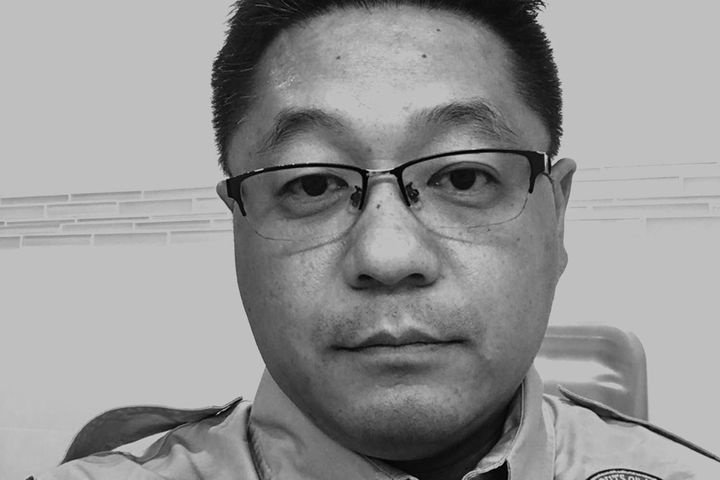
March 2020
While insisting the spread of the coronavirus in the U.S. wasn’t his fault, Trump turned to a common scapegoat: China. The president repeatedly referred to the coronavirus as “China virus,” “kung flu” and “Wuhan virus.”
Viruses are no longer named after places because of the potential for harm for nations and people. Asian Americans reported a swell of hate incidents related to the coronavirus.
James Chen, a 45-year-old Taiwanese American small business owner in Queens, New York, said the president’s rhetoric amplified the xenophobia and that his business faced a double whammy — a financial loss incurred by the pandemic lockdown and a bias that unfairly led customers away.
I’m proud to be a Chinese, Asian American in this country. So when [Trump] used the word “China virus,” I wasn’t too happy about it. I felt like it was very discriminatory.
Asian Americans, especially Chinese Americans, are being discriminated against. I felt this way when I was out on Long Island, during the beginning of the pandemic. I was out wearing a mask in Rite Aid, and I felt other people being uncomfortable [with my presence] and they looked at me very weird. I wanted to say I’m protecting you guys, but unfortunately, it’s what it is.
Everyone is being affected in some way. I lost my aunt last year, due to coronavirus. A lot of people have lost or knew someone who passed away from coronavirus.
Asian Americans, especially Chinese Americans in this country, take the coronavirus very, very seriously. During the beginning of this pandemic, they were the first ones to wear a mask. They are the first ones to shut down their businesses, the first ones to sanitize their business.
We want to stop the spread. Don’t put this tag on us — Asian virus or China virus. It’s really unfair.
― As told to Rowaida Abdelaziz

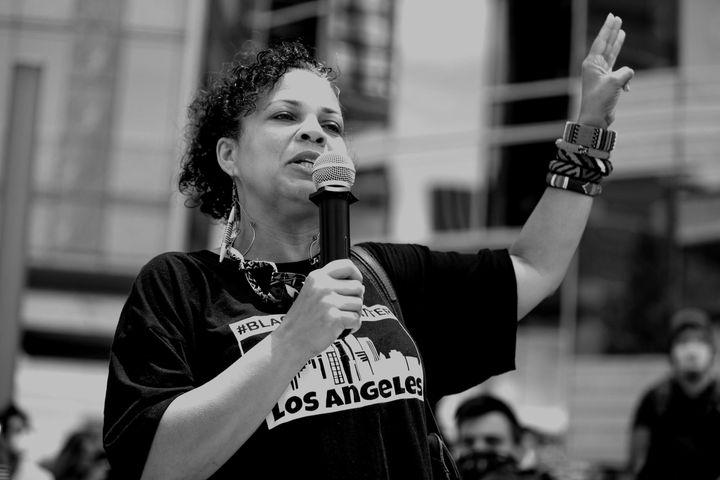
June 1, 2020
A week after the death of George Floyd at the hands of Minneapolis police, thousands of people, led by Black Lives Matter organizers, showed up at the gates of the White House to protest racism and police brutality.
Trump directed law enforcement to tear-gas and launch rubber bullets at the peaceful protesters so he could walk to the historic St. John’s Episcopal Church just a few blocks away. Once there, he posed with a Bible for a photo-op and said, “Greatest country in the world. And we’re going to keep it safe.”
Melina Abdullah, the co-founder of Black Lives Matter Los Angeles, was watching in horror from across the country.
The idea that Black Lives Matter organisers were out to protest police brutality and Trump used police brutality to silence those protesters ― it was a reminder of how deeply entrenched police violence is in this country.
Trump’s photo-op and the police crackdown on protesters was just days after [the death of] George Floyd. Those who want to maintain an oppressive and racist regime are perhaps most threatened by the organising component. That’s where I think you see the call for police violence against protesters ― it’s because Trump was threatened by the protest. The lesson for us is we can’t give up the protest, even in the midst of a pandemic.
We have to both vote and organise. We have to engage in both protest and politics. We don’t just organise to vote. When we vote folks into office, we also have to ensure that they carry the agendas of the folks who voted them in.
I feel so relieved knowing that Trump is leaving office. We’re not under the illusion that just because Biden and Harris are in the White House, all of a sudden Black freedom comes. There’s no illusion there. But Donald Trump was absolutely the most oppressive, repressive, racist, sexist, violent so-called leader we could have. So I am relieved to see him go. I think the whole world is exhaling. We’re all sharing a collective sigh of relief.
― As told to Alanna Vagianos

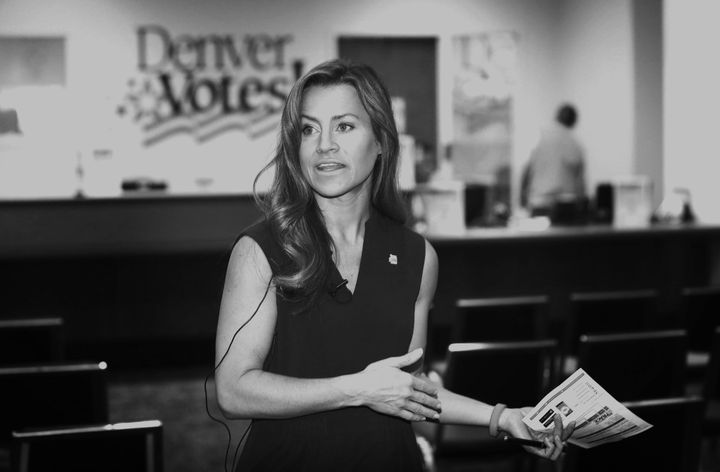
Summer 2020
The Justice Department and election officials nationwide have stated repeatedly that there’s no evidence widespread voter fraud occurred during the 2020 election, and yet Trump has continued to falsely claim for months that the Democrats “rigged” the process against him. He’s been especially critical of mail-in voting, making unsubstantiated allegations of election fraud and whipping his base into a frenzy.
As CEO of the nonpartisan National Vote at Home Institute, Amber McReynolds has spent the last two years helping state and local election officials across the country expand and secure their vote-by-mail systems. She’s been the target of constant harassment online in recent months amid Trump’s whirlwind of misinformation about mail-in ballots.
In the weeks after the election is when the death threats started. I had tweets directed at me [with] a picture of a noose saying that I should be hung for treason and executed for being a traitor. There was one tweet that had a picture of my kids in it, which was the one that really disturbed me the most. They got pretty bad, to where we actually hired off-duty police officers to be stationed outside my house for three or four weeks.
My election official friends have been targeted in unprecedented ways this year, and they’re just trying to do their jobs. I’m running a nonprofit now and I understand people aren’t always going to agree with what we’re trying to do, but ultimately all we’re trying to do is improve the election process for every single American and make sure it’s safe, secure and accessible.
The election officials, my heart breaks for them because they’re already under a very stressful situation and to have them get death threats or be followed to their cars or be harassed online or doxed on social media ― it’s just unbelievable.
I just never in my wildest dreams would have expected that an elected official ― at any level ― would do what has happened, not only with the president but also local officials and state legislators who have pushed these crazy conspiracies not based in fact. I just never expected that to occur in the United States of America.
― As told to Hayley Miller

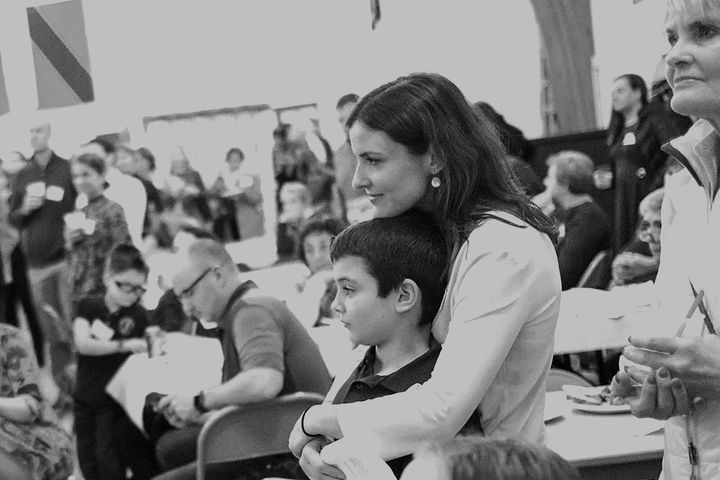
December 8, 2020
Trump downplayed the threat of COVID-19 from the get-go, repeatedly peddling misinformation about its transmission and mocking people who wore masks. His divisive and baseless rhetoric fired up supporters, some of whom staged armed protests against state and local officials making decisions about coronavirus mitigation measures.
Ada County Commissioner Diana Lachiondo of Idaho, a member of her district’s public health board, was the target of one such protest. She tearfully excused herself from a health board meeting on a potential mask mandate after she learned protesters were surrounding her house. Her two children were home alone.
At the time, I thought it was just my 12-year-old, but it turns out it was my 12-year-old and my 8-year-old. He was upset and I just felt really helpless. I had to get home to my son. He’s scared. There’s people outside our door and I don’t know what’s going on. … I just can’t believe where we’ve come to as a community and as a country, really. It’s just ― it’s sad.
I’ll tell you the most frustrating thing is that I get a weekly report from the White House coronavirus task force with recommendations about what we should be doing from a mitigation standpoint. At one point, [task force member] Deborah Birx herself was on the phone with just me and the health board member from our neighbouring county, and she wasn’t calling because we were doing so great over here; she was imploring us to take measures. Simultaneously, we’re watching the president fan the flames of some of this rhetoric against the governor of Michigan and just in general.
The disconnect between what his own task force was asking us to do and these weekly White House reports and then what he was doing ... was incredibly frustrating. I, at this point, feel like it’s had real consequences for my family. That’s not leadership.
― As told to Hayley Miller


January 6, 2021
Trump ― through his incessant false claims of voter fraud ― for weeks sowed defiance and distrust of the election results among his base. On Jan. 6, he addressed thousands of his supporters in Washington, D.C., and called on them to march on the U.S. Capitol. Many of them heeded his orders, forcing their way into the building. The violence resulted in at least five deaths, including a police officer who died after a pro-Trump rioter bludgeoned him in the head with a fire extinguisher.
Because of the pandemic, Justin Goldberger, a senior policy adviser to Rep. Donald McEachin (D-Va.), was working from home when the insurrectionists began storming the Capitol. He frantically called and texted his colleagues who were inside as he watched the insurrectionists attempt to overthrow the seat of the nation’s government.
Symbols of hate, including the Confederate flag and neo-Nazi iconography, were paraded through the Capitol. Goldberger — a co-chair of the Congressional Jewish Staffers Association whose boss is the third Black congressman ever to represent Virginia — found them particularly hard to see.
You see your place of work turn into a war zone. There’s tear gas, there are protesters, and you’re frantically texting your colleagues and just making sure that they’re OK. It’s tough because every minute you don’t hear back, you’re wondering.
The toughest part is seeing a place you’re so familiar with, and you see every day and have all these memories in, just kind of implode.
You saw people quoting Hitler. You saw Nazi paraphernalia. And not even from a Jewish perspective, but I work for a [Congressional Black Caucus] member ― you saw nooses hung up. And just seeing that was I think equally as jarring and just disheartening, not only as a Capitol Hill staffer but just as an American.
Personally, do I think that some institutions probably incentivized or didn’t at least do their part to stop this? Absolutely. … On the opposite side, seeing us go back to work right afterward and say, you know, we’re not going to let this affect our timeline for making sure democracy runs its course was equally as heartening.
― As told to Hayley Miller
Responses have been lightly edited for clarity.